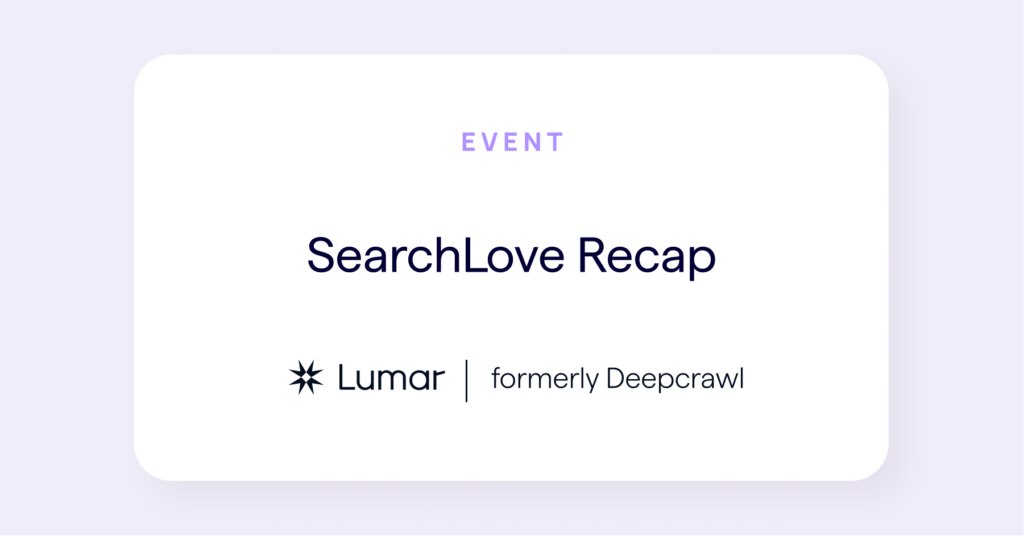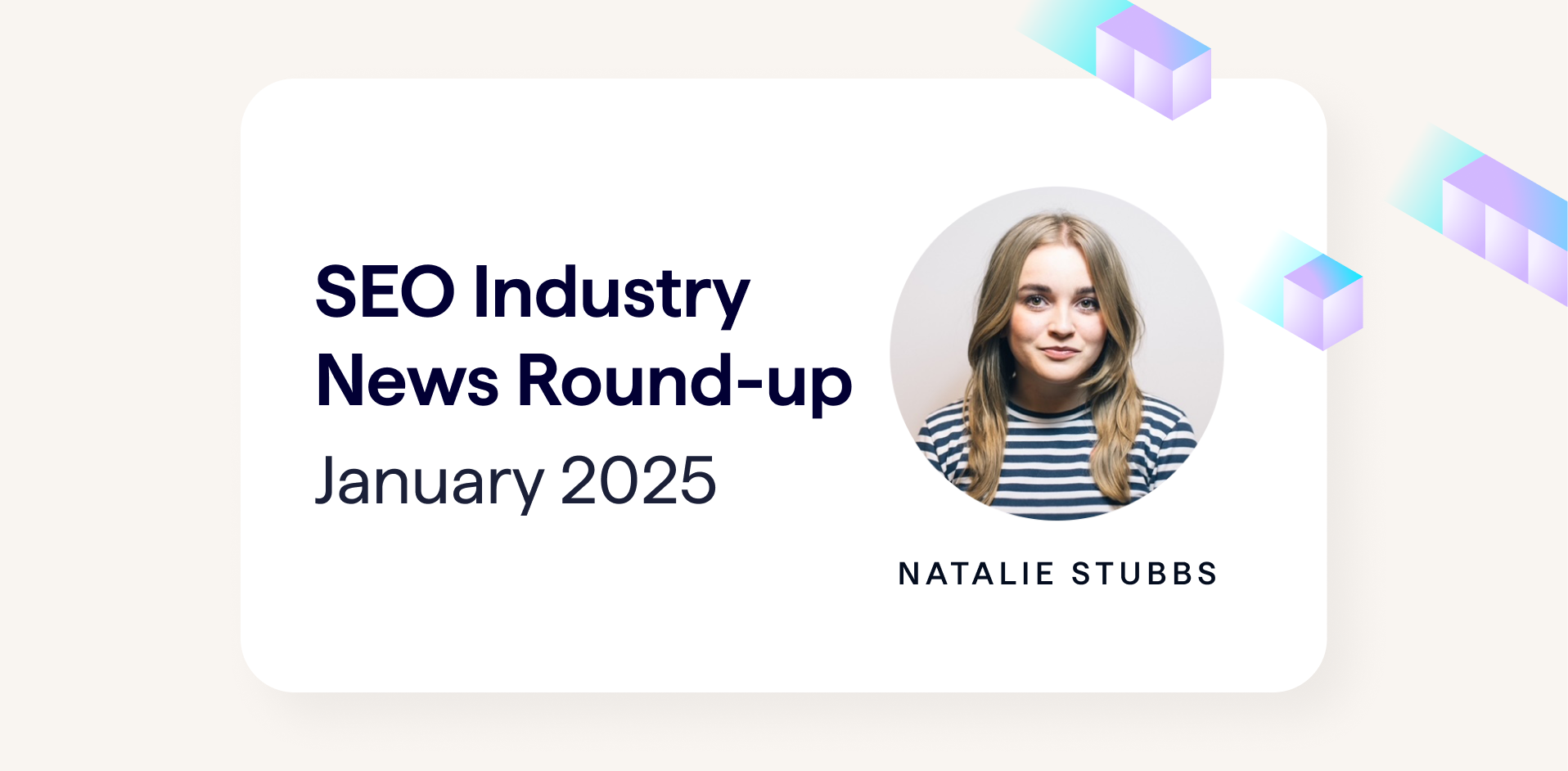We were proud to attend and sponsor SearchLove 2017, not least for all of the insightful sessions that were jam-packed with SEO knowledge.
Let’s not waste any time and get into the final recap in our three part series. If you haven’t read them already, here is part 1 and part 2.

Jon Myers – Mobile-first Preparedness- What We’ve Learned From Crawling the Top 1 Million Websites
Talk Summary
DeepCrawl’s Chief Growth Officer Jon Myer’s gave the SearchLove crowd a data-packed talk revealing how ready the world’s top sites are for Google’s Mobile-first index. After crawling the Majestic Million, Jon presented his findings from analysing this humungous dataset.
Key Takeaways
- There are now 2 trillion Google searches per year and 15% of these queries are original.
- We have been talking about mobile for many years from WAP of 1999 to Mobile-first Indexing which is set to be implemented by Google in early 2018.
- We know from Google that, in their opinion, responsive design is the optimal situation.
What Did We Find From Crawling the Majestic Million?
- At DeepCrawl we took on the ambitious project of crawling and analysing data for all one million sites from the Majestic Million to see what the mobile landscape looks like and how much work is required to make sure these sites are Mobile-first ready.
#searchlove @JonDMyers from @DeepCrawl impact of mobile first index pic.twitter.com/C1SSpRQftY
— David Iwanow (@davidiwanow) October 16, 2017
What did we find?
1. Of all the sites where a mobile configuration could be detected, 80% of sites are responsive, 19% were dynamic and 1% had a separate mobile site.
2. Separate Mobile sites can be difficult to configure and maintain. We found only 61% had a correct canonical tag to the desktop page, 21% had no canonical to the desktop equivalent and 18% had a canonical pointing to an incorrect page.
3. Only a small proportion of Separate Mobile sites have matching titles, meta descriptions or both matching titles and meta descriptions (7.7%, 7.9% and 5.8% respectively).
4. Other Separate Mobile issues include: 1% had noindex meta tag and 25% returned a non-200 status code.
5. Dynamic sites aren’t well configured either. A massive 91% of dynamic sites didn’t have a Vary HTTP response header.
6. Fetch times for the Majestic Million were surprisingly quick (1.22s average) and a follow up crawl will look to verify this.
7. Looking at Google’s research on speed consumer facing sites seem to have more responsive servers, with a lower average time to first byte. Technology sites seem to be lagging behind when it comes to Google’s average speed index.
8. 78% of sites haven’t yet migrated to HTTPS. This goes against other measures of HTTP adoption (e.g. Mozcast) which state that SSL encryption has reached critical mass.
9. Despite the previously identified configuration issues, HTTPS adoption is higher with Separate Mobile sites compared to other mobile configurations.
10. Looking at TLDs, edu and gov domains have among the highest proportion of responsive sites, suggesting they have little to do in preparation for Mobile-first.
Very surprised by this https adoption stat shared by @DeepCrawl’s @JonDMyers #searchlove pic.twitter.com/gaLfK14cXm
— James Bavington (@bavington) October 16, 2017
Our crawl of the Majestic Million looked at the state of play with regards to site’s readiness for Mobile-first Indexing, but what does the future hold? Jon says that Progressive Web Apps are something we should be thinking about now.
Wil Reynolds – Power BI for Marketers
Wil’s compelling talk showed how search marketers can use Power BI and other business intelligence tools to piece together wide ranging data sources and visualise them in a way that effectively communicates the value of their insights to the C-suite.
Key Takeaways
Let’s talk about money – SEOs don’t talk about money enough and as a result PPC gets all the money.
Read 4 Disciplines of Execution – This book has saved Will’s life and given him a framework for prioritisation.
Ask yourself these questions:
1. What’s the one area where change will have the biggest impact? This will create instantaneous focus.
2. What are your Wildly Important Goals (WIG)?
3. What is your vision? You need to have a vision so that you can power through when shit gets tough.
Wil uses Power BI Domo and Tableau – Wil got taught these tools by a college intern. They are mainly used by finance people, so you won’t find marketing or search videos on them.
How do you evaluate the current state of a site’s keyword research?
Step 1 – Talk with your client – Who are competitors
Step 2 – Tools, tools, tools
Step 3 – Apply CTR – But if you use click-through curves you’re a moron!
Plot keywords on position and clicks (size of bubble is conversion).
Build a data warehouse
1. Go to AdWords report tab, put your data in, export it. Get top rows from landing pages, export into Excel. Export keyword data from SEMrush.
2. Clean up the data so that domains are same format using Find & Replace. Weave data together. Build these datasets out so you can see more.
3. Create folders for each datasets, then apply macros to automatically clean the data. You may encounter instances where you can get duplicate values. Simply delete one source (usually SEMrush).
Other things to consider:
- Adding filters e.g. overlaying organic metrics with average CPC.
- Be careful not to average averages and don’t sum positions (easier to do than you think).
- Integrate 3 datasets from different disciplines (e.g. PPC, SEO, Analytics).
- Remove outliers to expand visuals.
- Bring together data from technical SEO and PPC. For example if you have high converting KWs (PPC), with short titles (technical SEO) and high ranking then you can look at optimising these titles.
Zee Hoffman Jones – A Competitive Analysis that Saved $337,000
To match up and edge out your competitors you need to perform in-depth competitor analysis and size up those around you. Zee’s engaging talk provided a replicable framework for understanding your competitive landscape, including a step-by-step guide for the steps Distilled takes to undergo this investigation and how she saved Broadway Direct $337,000.
Key takeaways:
Zee has been working with Broadway Direct, a theatre events company with excellent writers and content. They had some cool features in the pipeline but seriously needed some competitor analysis which would inform their marketing strategy rather than blindly going ahead and spending significant sums of money on new features.
If you can’t answer these three questions, then how do you know what features you need?
Who are your search competitors?
Who are your audiences?
What are your business goals?
You’ve got to see what others are doing in your space.
How do we find our competitors?
- Start with your favourite tools – SearchMetrics, SEMRush.
- Find relevant competitors. Where is their overlap?
- Next we need sample page sets – mixture of 5 sample pages per domain. Product pages, editorial pages, browse pages, homepages. Pick based on analytics data, where are visitors spending time?
Answer these questions using a five-point scale for these key areas to create the balanced digital scorecard (do this for your site and for a select group of relevant competitors):
Platform:
- Are pages well optimised?
- Does internal linking promote indexable content?
- Is schema present, valid and relevant?
- Are they messing up technical SEO? Try using Ayima Page Insights extension.
- Is there a home for new content?
Content
- Are pages are editorially optimised?
- Does internal linking promote organic content?
- Is there appropriate transactional and informational content?
- Is the content of a high quality?
- What are the quality of images and videos like?
Audience:
- Do they have linking root domains?
- What is the quality of linking root domains like?
- Are they promoting content?
- Is content created to attract organic traffic?
- Are they creating engaging content for users?
Conversion
- Are there clear CTAs on the site?
- Are the steps to conversions are appropriate? How much friction is there?
- Do the CTAs match the user intent?
- Is there a clear link between conversions and revenue?
For those at #searchlove, here is the full fledged competitive SEO checklist (preso to come!): https://t.co/D885GPCjEe
— zee hoffmann jones (@ItsZeezle) October 17, 2017
The secret to success is being empathetic and better understanding what is going on with a brand including your competitors.
Download Zee’s SEO Competitive Analysis Spreadsheet and go through this process yourself.
Kirsty Hulse – The Content Flop
What should you do when a campaign doesn’t perform as expected? Kirsty entertained the SearchLove crowd with tips and tricks learnt from personal experience to help you deal with those times when a plan isn’t coming together.
Key takeaways
Kirsty has furniture client and created a campaign taking a sofa around London and interviewing people post-brexit to show unity in the city.
However, the London attacks happened so decided to drop it and they had nothing to fall back on. As a result they only got two links and some social shares.
Top 3 tips when content fails:
1. Panic
2. Get drunk
3. Run a food truck.
How can we prevent a campaign from flopping?
Content calendars can be problematic because you’re relying on one campaign. If that campaign doesn’t work then you have to wait a while for the next one. Solution: run smaller campaigns to supplement the larger campaign.
What makes content successful? A good idea, access to reliable, trustworthy, authoritative data and creation of an asset.
Some examples of successful content include this by CEWE Photoworld and this one about Bond cars.
It can be hard to have to have multiple good ideas at the same time so what can you do?
Data = Easy and cheap. Assets = Expensive and hard. Can we get results without an asset?
This piece on how much singers cost to hire is ugly but effective in gaining links and shares.
A lot of ideas struggle to get links because they look like advertising.
When your #ContentStrategy is struggling. @Kirsty_Hulse speaking now at #SearchLove #content #seo #london pic.twitter.com/GHZJRfsN4E
— Manyminds (@manym1nd5) October 17, 2017
For typically boring industries and subject matter find connections between ideas by setting minute timer on phone and scribble down ideas associated with client.
Internal or publically available data is gold. Huge opportunity for client side content creation to utilise data available from company.
Repurpose data from data from dense whitepapers.
DataSearch – research data search engine. Potential for academic links.
Links are the output of the strategy, not the goal.
A useful content framework:
O – Top level business objectives. Normally wooly (increase business revenue by 20%)
G – Specific goals e.g. organic traffic, organic revenue
S – Strategies to achieve those goals e.g. producing content
M – KPIs and measurement
Key insight from @Kirsty_Hulse of @manym1nd5 during @distilled‘s #SearchLove London 2017 conference! #seo pic.twitter.com/Z6U1gmsWbq
— Outbrain (@Outbrain) October 18, 2017
Fail quickly and be transparent.
Be ruthless and notice when something isn’t working and move on. Don’t get emotionally attached to content.
Samuel Scott – The Day After Tomorrow, When Ad Blockers Stop All Analytics Platforms
Samuel put forward a damning vision of the not too distant future in which marketers could be severely limited in the consumer data they have access to. Samuel predicts that incoming GDPR regulation pushing for consumers to opt-in to personal data collection coupled with the rise of ad blockers will mean a switch back to brand advertising rather than direct marketing.
Key takeaways
Two types of marketing – Brand advertising and direct marketing. Internet hasn’t changed this paradigm, it’s just a new medium.
Brand advertising – creative, memorable and builds brand but can flop, expensive and hard to track impact and prove results.
Direct marketing – Cheaper, trackable, adjustable but boring, not memorable and can be annoying.
Digital marketing has gone all-in on direct marketing and advertising is now talked about synonymous with direct marketing.
Increase in adblocking correlates with growth of retargeting @samueljscott #SearchLove pic.twitter.com/ORDHrNCYos
— olivieredme (@olivieredme) October 17, 2017
Most people don’t want tailored ads. Growth in retargeting is correlated with rise in ad blocking.
Is this direct marketing a good way to build a brand? Is it worth converting a few percent if majority of audience is annoyed.
20% of people online use ad blockers in Western Europe and 18% in North America. 14% of millenials have ad blockers on both desktop and mobile. VPNs and DuckDuckGo are also becoming increasingly popular.
Ad blockers block many front end scripts, not just ads – Google Analytics and social media tracking can be easily blocked.
The Die after Tomorrow: When #Adblockers Stop all #Analytics Platforms @samueljscott at #SearchLove #GDPR will apply 25 May 2018 #privacy pic.twitter.com/bsNxHPsEf1
— Peer (@supeerseo) October 17, 2017
GDPR regulation – if your company processes or analyses data be aware. Consumer must opt-in to all personal data collection. Opt-in can be withdrawn and data erased at request. Up to €20 million fine for non-compliance. GDPR doesn’t discriminate between tracking and non-tracking cookies.
Bottom line – 75% of UK marketing data will become obsolete because will have been collected in violation of GDPR
What can you do? Understand your data supply chain, comply with GDPR, use analytics platforms that are not blocked by script blockers and lobby to change the GDPR draft (it’s not too late!)





